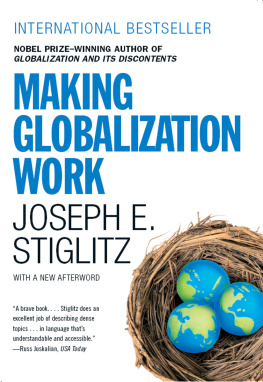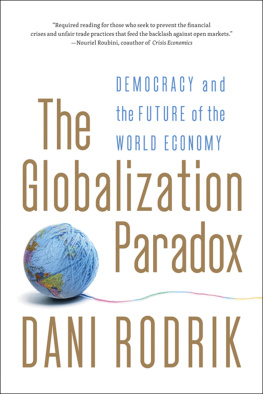Aaronson - Taking Trade to the Streets: The Lost History of Public Efforts to Shape Globalization
Here you can read online Aaronson - Taking Trade to the Streets: The Lost History of Public Efforts to Shape Globalization full text of the book (entire story) in english for free. Download pdf and epub, get meaning, cover and reviews about this ebook. publisher: The University of Michigan Press, genre: Politics. Description of the work, (preface) as well as reviews are available. Best literature library LitArk.com created for fans of good reading and offers a wide selection of genres:
Romance novel
Science fiction
Adventure
Detective
Science
History
Home and family
Prose
Art
Politics
Computer
Non-fiction
Religion
Business
Children
Humor
Choose a favorite category and find really read worthwhile books. Enjoy immersion in the world of imagination, feel the emotions of the characters or learn something new for yourself, make an fascinating discovery.
- Book:Taking Trade to the Streets: The Lost History of Public Efforts to Shape Globalization
- Author:
- Publisher:The University of Michigan Press
- Genre:
- Rating:4 / 5
- Favourites:Add to favourites
- Your mark:
- 80
- 1
- 2
- 3
- 4
- 5
Taking Trade to the Streets: The Lost History of Public Efforts to Shape Globalization: summary, description and annotation
We offer to read an annotation, description, summary or preface (depends on what the author of the book "Taking Trade to the Streets: The Lost History of Public Efforts to Shape Globalization" wrote himself). If you haven't found the necessary information about the book — write in the comments, we will try to find it.
Aaronson: author's other books
Who wrote Taking Trade to the Streets: The Lost History of Public Efforts to Shape Globalization? Find out the surname, the name of the author of the book and a list of all author's works by series.
Taking Trade to the Streets: The Lost History of Public Efforts to Shape Globalization — read online for free the complete book (whole text) full work
Below is the text of the book, divided by pages. System saving the place of the last page read, allows you to conveniently read the book "Taking Trade to the Streets: The Lost History of Public Efforts to Shape Globalization" online for free, without having to search again every time where you left off. Put a bookmark, and you can go to the page where you finished reading at any time.
Font size:
Interval:
Bookmark:

Copyright by the University of Michigan 2001
All rights reserved
Published in the United States of America by
The University of Michigan Press
Manufactured in the United States of America
 Printed on acid-free paper
Printed on acid-free paper
2004 2003 2002 2001 4 3 2 1
No part of this publication may be reproduced, stored in a retrieval system, or transmitted in any form or by any means, electronic, mechanical, or otherwise, without the written permission of the publisher.
A CIP catalog record for this book is available from the British library.
Library of Congress Cataloging-in-Publication Data
Aaronson, Susan A.
Taking trade to the streets : the lost history of public efforts to shape globalization /
Susan Ariel Aaronson ; with forewords by Pat Choate and I.M. Destler.
p. cm.
Includes bibliographical references and index.
ISBN 0-472-11212-0 (cloth : alk. paper)
1. Free trade. 2. Foreign trade regulation. 3. Canada. Treaties, etc. 1992 Oct. 7. 4. General Agreement on Tariffs and Trade (Organization) 5. World Trade Organization. 6. Globalization. 7. Free TradeUnited States. 8. United StatesCommercial policy. I. Title.
HF1713 .A15 2001
382dc21 2001027049
ISBN13 978-0-472-11212-8 (cloth)
ISBN13 978-0-472-08867-6 (paper)
ISBN13 978-0-472-02223-6 (electronic)
ONE OF THE IRONIES surrounding most contemporary policy debates is the reportage seems to concentrate more on personalities and tactics than on the substance of the issue. Consequently, the effects of any policy shifts increasingly seem to come as a surprise to the general public, and, when noticed, are too often viewed as isolated events rather than as part of larger structural change.
Certainly, the ongoing debates and changes in U.S. trade policy fit this description. For example, the fights to ratify the North American Free Trade Agreement (NAFTA) and the Uruguay GATT Agreement were largely portrayed at the time as a battle between the forces of good and bad. The forces of good were the free traders, led by newly elected President Bill Clinton. The bad were the protectionists, led by a coalition of national figures that included Ralph Nader, Patrick Buchanan, Jerry Brown, and Ross Perotwhat White House spinners called the Halloween Coalition.
Of course, much can be lost in such radical simplification, and it was. Most important, the longer-term dimensions of the underlying structural shiftwhat has come to be known as globalizationtend to be unanalyzed with vital parts unnoticed. And often the result is costly indeed; for example, the $100 billion bailout of the Mexican economy in the mid-1990s, the ongoing loss of key sectors of the U.S. economy such as steel and textiles, and the recurring need for public bailouts of U.S. banks, to name only three.
Yet even where debate and discussion do occur, even between economists and scholars, epigrams and cliches dominate. In a perverse sense, those who study the topic the most seem trapped the deepest in the ideology and techniques they acquired in their early academic training. Perhaps this educated incapacity is normal. After all, the Marxist economists in the Soviet Union and East Germany were offering their orthodoxy even as those economies and societies were falling apart.
But for the interested lay person and public officials, this debate via epigrams produces more confusion than information. Most economists, for instance, argue that a large and growing portion of finance, commerce, and communication is increasingly unaffected by national borders. That is true. But the implication is that somehow the world is headed to a homogenized economy. That is not true. The differences between nations, their cultures, and their institutions are real and often so fundamental as to be insurmountable without a dangerous political revolution.
In the 1990s, a clever attempt was made to reconcile that paradox of economic globalization versus national differences. The resultant creation was the World Trade Organization (WTO)a new international body that provides a forum for the negotiation of global trade rules, their administration, and their final judicial review. The creators of the WTO also endowed the organization with the authority to confront the domestic policies, practices, and regulations of member nations that might affect trade. With this, a new era of global regulation was born.
Brought into being in 1995 and located in Geneva, Switzerland, the WTO is at a nascent stage where its powers are only partially defined.
At a time when dozens of homeless transnational corporations with annual sales greater than the gross domestic products of all but a handful of nations are essentially unregulated, perhaps a strong, global regulatory body is necessary. The primary need for such a body may be more to ensure that these corporations act responsibly in their global activities than to protect the parochial economic interests of any single country. But that debate awaits.
In Taking Trade to the Streets: The Lost History of Public Efforts to Shape Globalization, Susan Aaronson provides a clear, cogent, thoughtful context for that discussion.
As she discusses in her early chapters, the political fight over terms of trade is as American as apple pie. It stretches from the Boston Tea Partywhen American colonials dumped British tea into the harbor to protest English import taxesto todays street demonstrations against the World Trade Organization.
Susan Aaronson tackles the clichd nature of the current debate, using as a starting point the late Governor Adlai E. Stevensons observation that trade policy is one field where the greatest need is for fresh cliches. Then, she goes behind the labels of free trade and protectionism to describe the substantive, multilayered positions of the various participants; most notably those involved in the NAFTA and WTO ratification battles of the 1990s. It is a good history, presented in crisp writing that moves along, providing a factual overview that is understandable to the lay reader.
The publication of this book is timely, coming at the end of the Clinton administration and the beginning of George W. Bushs. The era of vast trade negotiations between nations that characterized the Clinton years may well be over. The WTO has been created to shepherd that process for the future. Those future negotiations are likely to be less seismic than what came during the 1990s.
Rather, the big changes that await are likely to be those of a regulatory nature, as the author points out. Already the power of nations to set their own rules is being challenged by the WTO. Further, the WTO may well have the mandate to regulate global business, something that none of its individual members seems able to do effectively. Inevitably, demands will be made on that body to perform that function. And if that road is taken, the world enters an entirely new and uncharted phase of globalization.
With Taking Trade to the Streets, Susan Aaronson makes a major contribution to the understanding of where the United States, indeed the world, is in this heretofore largely undocumented evolution.
Pat Choate
Economist and Author,
Director, Manufacturing Policy Project,
Washington, D.C.
FOR TWO-THIRDS OF a century now, the United States has pursued a policy of reducing barriers to international trade. In the FDR years, we did so by negotiating bilateral deals with our principal trading partners. With the signing of the General Agreement on Tariffs and Trade (GATT) in the late 1940s, the means shifted to multilateral negotiationsfirst primarily with Europeans, but increasingly with nations around the globe. But the basic structure of bargaining remainedwe sought reductions in foreign barriers to our products, and lowered our own trade barriers in exchange. Social issueslabor practices, environmental policies, human rightswere largely excluded from the discussion.
Font size:
Interval:
Bookmark:
Similar books «Taking Trade to the Streets: The Lost History of Public Efforts to Shape Globalization»
Look at similar books to Taking Trade to the Streets: The Lost History of Public Efforts to Shape Globalization. We have selected literature similar in name and meaning in the hope of providing readers with more options to find new, interesting, not yet read works.
Discussion, reviews of the book Taking Trade to the Streets: The Lost History of Public Efforts to Shape Globalization and just readers' own opinions. Leave your comments, write what you think about the work, its meaning or the main characters. Specify what exactly you liked and what you didn't like, and why you think so.












